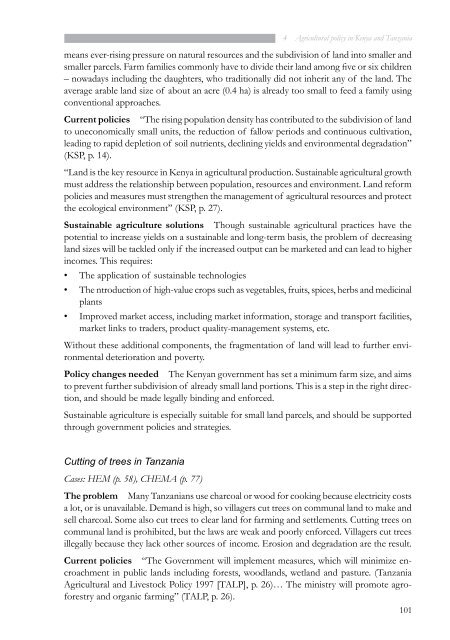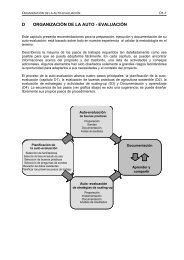cases from tanzania - Sustainet
cases from tanzania - Sustainet
cases from tanzania - Sustainet
You also want an ePaper? Increase the reach of your titles
YUMPU automatically turns print PDFs into web optimized ePapers that Google loves.
4 Agricultural policy in Kenya and Tanzania<br />
means ever-rising pressure on natural resources and the subdivision of land into smaller and<br />
smaller parcels. Farm families commonly have to divide their land among five or six children<br />
– nowadays including the daughters, who traditionally did not inherit any of the land. The<br />
average arable land size of about an acre (0.4 ha) is already too small to feed a family using<br />
conventional approaches.<br />
Current policies “The rising population density has contributed to the subdivision of land<br />
to uneconomically small units, the reduction of fallow periods and continuous cultivation,<br />
leading to rapid depletion of soil nutrients, declining yields and environmental degradation”<br />
(KSP, p. 14).<br />
“Land is the key resource in Kenya in agricultural production. Sustainable agricultural growth<br />
must address the relationship between population, resources and environment. Land reform<br />
policies and measures must strengthen the management of agricultural resources and protect<br />
the ecological environment” (KSP, p. 27).<br />
Sustainable agriculture solutions Though sustainable agricultural practices have the<br />
potential to increase yields on a sustainable and long-term basis, the problem of decreasing<br />
land sizes will be tackled only if the increased output can be marketed and can lead to higher<br />
incomes. This requires:<br />
• The application of sustainable technologies<br />
• The ntroduction of high-value crops such as vegetables, fruits, spices, herbs and medicinal<br />
plants<br />
• Improved market access, including market information, storage and transport facilities,<br />
market links to traders, product quality-management systems, etc.<br />
Without these additional components, the fragmentation of land will lead to further environmental<br />
deterioration and poverty.<br />
Policy changes needed The Kenyan government has set a minimum farm size, and aims<br />
to prevent further subdivision of already small land portions. This is a step in the right direction,<br />
and should be made legally binding and enforced.<br />
Sustainable agriculture is especially suitable for small land parcels, and should be supported<br />
through government policies and strategies.<br />
Cutting of trees in Tanzania<br />
Cases: HEM (p. 58), CHEMA (p. 77)<br />
The problem Many Tanzanians use charcoal or wood for cooking because electricity costs<br />
a lot, or is unavailable. Demand is high, so villagers cut trees on communal land to make and<br />
sell charcoal. Some also cut trees to clear land for farming and settlements. Cutting trees on<br />
communal land is prohibited, but the laws are weak and poorly enforced. Villagers cut trees<br />
illegally because they lack other sources of income. Erosion and degradation are the result.<br />
Current policies “The Government will implement measures, which will minimize encroachment<br />
in public lands including forests, woodlands, wetland and pasture. (Tanzania<br />
Agricultural and Livestock Policy 1997 [TALP], p. 26)… The ministry will promote agroforestry<br />
and organic farming” (TALP, p. 26).<br />
101




